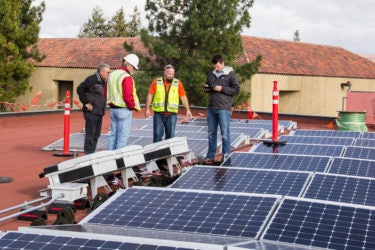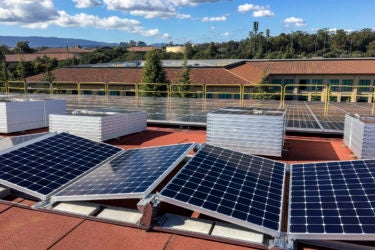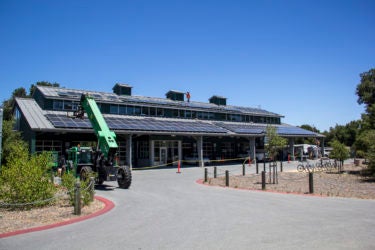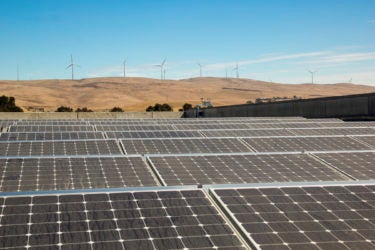Over the last nine months, 15 Stanford buildings – including Bing Concert Hall, Hansen Experimental Physics Lab and the historic Meyer-Buck House – have joined what is now a constellation of 32 structures with solar photovoltaic panels on their rooftops producing electricity for the Farm.
The project represents the conclusion of an ambitious plan Stanford launched in 2012, when the Department of Sustainability and Energy Management sought proposals from 20 solar companies to expand the university’s rooftop solar resources.
Stanford audited and analyzed 60 potential sites for the project in 2013. The following year the university chose 15 buildings for the project based on a variety of factors, including aesthetic concerns, orientation, roof size and slope, and construction issues.

Image credit: M. Scott Gould

Image credit: M. Scott Gould

Image credit: M. Scott Gould

Image credit: M. Scott Gould

Image credit: M. Scott Gould

Image credit: M. Scott Gould
“Fortunately, the main grid of campus is roughly on an east-west axis, meaning that the backs of our buildings are close to directly facing south – optimum direction for maximizing photovoltaic energy production,” said Scott Gould, senior energy engineer at Stanford. “We have several flat roofs – such as Bing Concert Hall and Braun Music Center – that are also ideal for photovoltaics. We worked closely with University Architect David Lenox on the project. He and his team provided input every step of the way.”
Construction began in May 2016 at the Automotive Innovation Facility on Oak Road. It concluded in February 2017, when crews finished installing solar panels atop Maples Pavilion, located on Campus Drive East.
The other buildings newly outfitted with solar panels are: Braun Music Center; 340 Bonair Siding, home of Transportation & Parking Services; Stanford Auxiliary Library I/II on Pampas Lane; Stanford Auxiliary Library III in Livermore; Stock Farm Parking Garage; Central Energy Facility; and the four buildings of the Kennedy Graduate Residences, which opened in 2014.
All told, the 15 buildings will provide an additional 4.5 megawatts of power for the campus, Gould said. The solar panels provide power within Stanford’s electric distribution system.
“The addition of on-site solar generation not only reduces the overall cost of electricity supply to our buildings, but will also help offset new campus electrical loads from plug-in buses and cars to help preserve the capacity of our campus high-voltage distribution system to support additional teaching and research activities,” said Joseph Stagner, executive director of the Department of Sustainability and Energy Management at Stanford.
Including the newly outfitted buildings, Stanford has 32 structures producing electricity with solar panels, including the 12 buildings that make up the Science and Engineering Quad and the Knight Management Center. Two buildings located in the Jasper Ridge Biological Preserve – its research and education facility and the ranger’s residence – have solar panels, as does Synergy House, a student-run cooperative, and the Lou Henry Hoover House, the president’s residence. In addition, a reservoir located near the Dish that is used to store domestic water in case of an emergency has solar panels.
The campus solar systems, plus the Stanford Solar Generating Station, which began operating in December 2016, will produce 53 percent of the university’s electricity.
After drawing on its solar resources, Stanford will purchase the balance of its electricity from the larger California power grid, which also is moving toward renewable energy sources, including solar, wind and geothermal.
For the rooftop solar panel project, the university teamed up with SunPower, the solar energy company that designed and built the Stanford Solar Generating Station.
The generating station was another major piece of the university’s cutting-edge energy supply system known as the Stanford Energy System Innovations (SESI) project, which also includes a revolutionary heat recovery system – completed in 2015 – for the heating and cooling of campus buildings.
Additional enhancements now under study include a new high-voltage transmission line connecting SLAC National Accelerator Laboratory, Stanford and the City of Palo Alto to further reduce electricity cost and increase system reliability; and the use of ground and water heat exchange to further increase system efficiency and save water.
Together, the new solar energy resources and renewables supplied by the balance of Stanford’s grid electricity purchases total 65 percent of university electricity use and reduce Stanford’s greenhouse gas emissions by 68 percent.
Additional information on Stanford sustainability initiatives is available at Sustainable Stanford, which describes the university’s commitment to being a leader in research, teaching and the institutional practice of environmental sustainability.